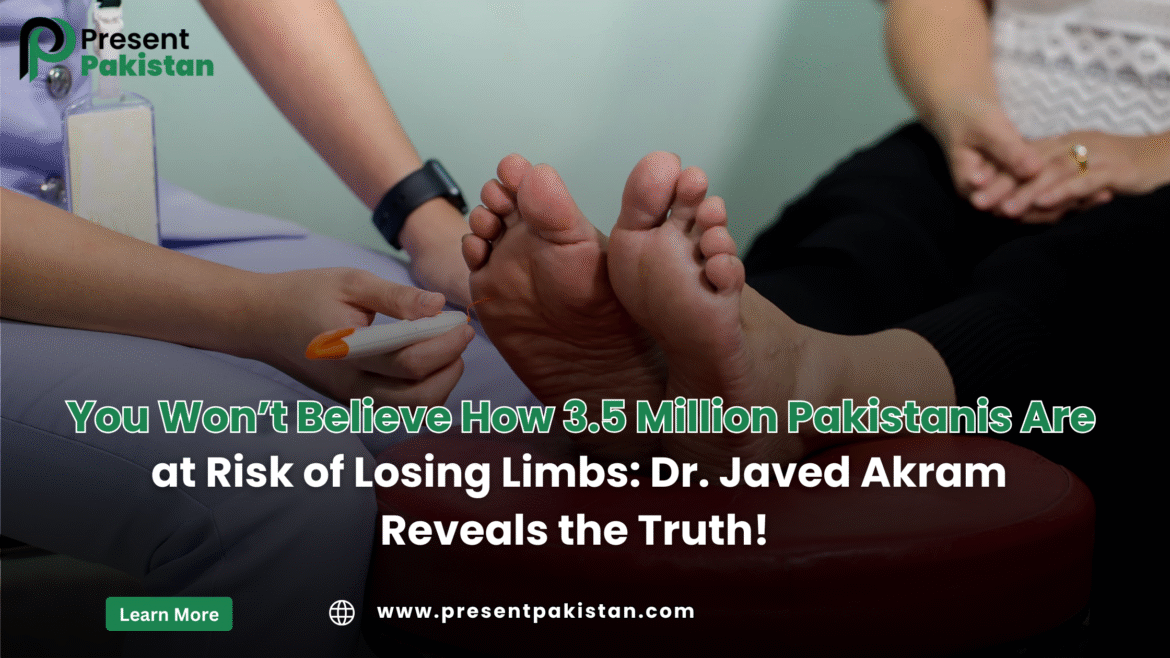Learn how 3.5 million Pakistanis are at risk of limb loss. Dr. Javed Akram shares startling statistics, causes, prevention tips, and treatment options for limb loss. Learn life-saving methods today.
3.5 Million in Pakistan at Risk of Limb Loss
3.5 million at risk in Pakistan is a startling realization, and it shows the health crisis that exists in Pakistan. It should not be alarming that millions of citizens will quietly develop conditions that will put them at risk of limb loss due to diabetic complications, poor health literacy, and delayed access to diabetic foot care. With the growth of diabetes, vascular incidences, and the lack of foot care in Pakistan, the nation is poised for a public health emergency.
Table of Contents
- Identification of the Emergency: 3.5 Million Pakistanis in Danger
- The Role of Diabetes in Limb Loss
- Other Causes of Limb Loss in Pakistan
- Regional Statistics and Vulnerable Populations
- Symptoms and Early Warning Signs
- Medical Expert Insights: Dr. Javed Akram’s Perspective
- Prevention and Lifestyle Changes
- Treatment Options and Medical Interventions
- Key Points and Action Plan
- Government Initiatives and Healthcare Policies
- FAQs
- People Also Ask
- Protect Your Health Today
Identification of the Emergency: 3.5 Million Pakistanis in Danger
Pakistan is currently facing a severe health emergency: 3.5 million Pakistanis are at risk of losing their limbs. The primary cause of limb loss is diabetic foot syndrome, which refers to nerve damage and/or blood vessel damage that can occur as a result of diabetes/from high blood sugar levels. Damage to the nerves or the blood vessels can lead to ulcers and infections, which ultimately lead to amputation.
Health reports indicate that:
- Over 26 million Pakistanis have diabetes.
- Roughly 15% of those patients with diabetes will develop a foot ulcer.
- Awareness and intervention can reduce the risk of amputation by 50%.
Key Points:
- Diabetic complications are the leading cause of limb loss in Pakistan.
- Awareness and early intervention are key to reducing risk.
The Role of Diabetes in Limb Loss
Diabetes mellitus, or diabetes, is the most common cause of injury to 3.5 million people in Pakistan alone. Hyperglycemia damages nerves (neuropathy) and blood vessels (completely dependent on blood flow, peripheral arterial disease), leading to decreased sensation and blood flow (especially to the feet).
Here are the different types of diabetes related issues.
- Neuropathy: Lack of sensation leads to unrecognized injuries.
- Peripheral Artery Disease: Lack of blood flow leads to slow healing.
- Infections and Ulcers: If an injury is not treated and deteriorates, it may turn into an irreversible critical infection.
Key Points:
- If blood sugar is controlled, complications can be lessened.
- If the feet are regularly checked for issues, it is possible to detect problems early and reduce limb loss.
Other Causes of Limb Loss in Pakistan
While diabetes is the leading cause of limb dysfunction, there are other causes of limb loss in Pakistan, such as:
- Peripheral Vascular Disease: Diminished perfusion because of atherosclerosis or other heart conditions.
- Trauma and Injuries: Road traffic accidents (including motorcycles and scooters), workplace incidents, and domestic injuries.
- Infections: Often, neglect of both bacterial and fungal infections can lead to gangrenous infections.
- Lack of access to medical services: Generally, rural populations cannot access clinics promptly enough to receive treatment.
Key Points:
- Diabetes is not the only driver of limb loss; there is a multitude of causes for limb loss.
- Increased awareness of the problem and appropriate treatment associated with limb loss will prevent the vast majority of cases.
Regional Statistics and Vulnerable Populations
Existing data show the risk of limb loss tends to differ by geography, and these differences are also affected by the context of risk factors such as
- Urban: an abundance of diabetes, but greater access to hospitals.
- Rural: low diagnosis rates, delayed treatment, and increased complications.
- Vulnerable populations: elderly poor families comorbid with hypertension.
Key Points:
- People in rural situations are disproportionately affected by these risk factors due to limited access to appropriate health care.
- Collectively targeting community programs may lessen the geographic risk in high-vulnerability populations.
Symptoms and Early Warning Signs
It is essential to recognize the signs! The most common warning signs include
- Numbness or tingling in the feet
- Wounds or ulcers that will not heal
- Swelling, redness, or heat
- Foul-smelling discharge from the wound
- Cold or discolored feet
Key Points:
- Address any wounds on the feet right away.
- Regular follow-up appointments will drastically improve the odds against amputations.
Medical Expert Insights: Dr. Javed Akram’s Perspective
Dr. Javed Akram, a highly regarded medical expert, emphasizes the importance of awareness and preventive medicine in saving 3.5 million Pakistani lives that are at risk.
He adds:
There is no education on foot care for rural and urban areas.
Screening programs could reduce the burden by 40%.
If treated early, it can perform poorly with the same outcome, but appropriate footwear, wound care, and controlling blood sugar can save lives.
Key Points:
- Expertise can help with limb preservation.
- Awareness campaigns can potentially provide solutions for millions of people to use preventative action.
Prevention and Lifestyle Changes
Preventive strategies can truly lower the risk:
- Blood Sugar Control: Self-monitor your blood sugars daily and take your medications as needed, which most people with diabetes need.
- Proper Foot Care: Inspect your feet each day, moisturize your feet each day, and never walk barefoot.
- Healthy Eating: Eat lower sugar, high fiber, and nutrient-dense food.
- Physical Activity: Physical activity should include some activity every day, improve circulation.
- Medical Check-Ups: Regular medical check-ups can help save limbs by screening for potential complications. Early detection is the best prevention.
Key Points:
- Changing lifestyle behaviors will reduce the severity of the complications associated with diabetes.
- Education and prevention services are important pillars in community health.
Treatment Options and Medical Interventions
Treatment options depend on the severity of the ulceration.
- Wound Care: Should be kept clean and protected; we will provide the dressing and hygiene with antibiotics, if needed, if an infection develops.
- Surgery: If your wound is more severe or has a ragged edge that you cannot control to proceed with the wound care, you may need to reduce it to debris and/or amputate.
- Other advanced therapies that are very efficacious include hyperbaric oxygen therapy, growth factors, and stem cell therapy.
Key Points:
- The sooner you seek treatment, the better for you! The sooner you seek treatment, the less likely you are to have an amputation.
- We are able to provide advanced medical interventions via numerous specialties.
Government Initiatives and Healthcare Policies
- National diabetes screening programs
- Rural Health Awareness Programs
- Subsidized medications/clinics
- Public-Private Partnerships for Preventive Healthcare
Key points:
- Policy support strengthens community health.
- Authentic participation enhances program outcomes.
FAQs
1. Who are the 3.5 million Pakistanis at risk?
These individuals are diabetic patients, specifically those who are poor foot care givers, diagnosed with diabetes for a long time, having long-standing uncontrolled hyperglycemia, and/or having limited accessibility to health care resources.
2. Can limb loss be prevented?
Yes. Regular foot care, optimal blood sugar control, timely medical follow-ups, and awareness programs significantly decrease risk.
3. What are the early warning signs of diabetic foot?
Symptoms that could be early signs of diabetic foot disease include numbness, non-healing wounds, swelling, discoloration, and/or foul-smelling discharge.
4. How does Dr. Javed Akram recommend preventing the loss of a limb?
He recommends lifestyle modifications, foot care education, screening programs, medical intervention, etc.
5. Are there any advanced treatments for advanced cases?
Yes. Advanced surgical intervention options are available, such as hyperbaric oxygen therapy or stem cell treatments, etc.
People Also Ask
Q1: What is the seriousness of limb loss risk in Pakistan?
Extremely serious. With 26 million people with diabetes, people are losing limbs every year due to the untreated complications of diabetes that involve the foot. An ounce of awareness and an ounce of prevention are extremely valuable.
Q2: Can limb loss risk be avoided with healthy lifestyle changes?
Yes. Healthy lifestyle changes are effective, and when combined with careful blood sugar control, diet, exercise, and foot care, they greatly reduce risk, but it is also necessary to have medical oversight.
Q3: How can communities reduce risk?
Community programming, awareness initiatives, and access to screening clinics provide opportunities for millions of people to take action in prevention.
Q4: What is the role of doctors (and staff) in preventing limb loss?
Doctors (and staff) help clinicians with blood sugar management, wound management, and they can identify conditions that require action in order to save limbs.
Q5: Are people living in rural areas more vulnerable?
Yes. People living in rural areas are particularly vulnerable due to a lack of awareness, a lack of health care access, and late presentation for care.
Protect Your Health Today
If you or a loved one is part of the 3.5 million Pakistanis at risk, act now! Learn more about prevention, early detection, and treatment options by visiting Present Pakistan. Protect your limbs and safeguard your future today.







